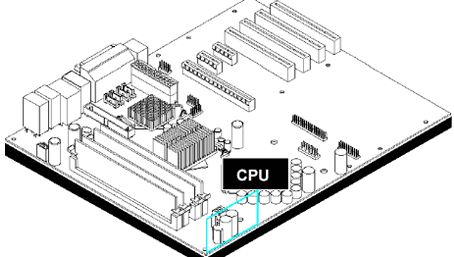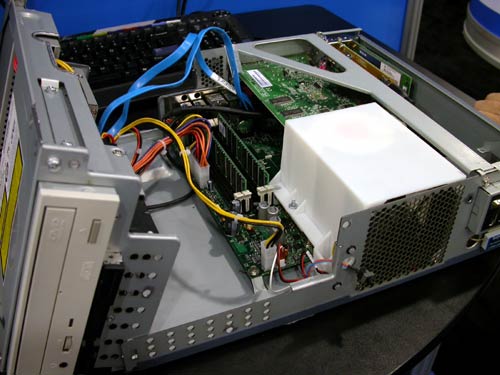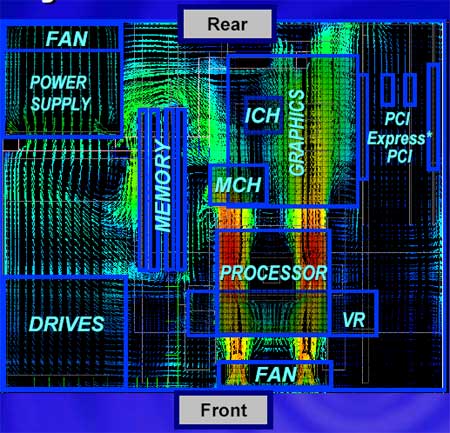AMD's DTX Form Factor: Smaller PCs for Everyone?
by Anand Lal Shimpi on October 22, 2007 1:00 AM EST- Posted in
- Cases/Cooling/PSUs
Differences between BTX and DTX
The BTX specification document is a hefty 32 pages compared to DTX's 10, mainly because the form factor is a more dramatic departure from ATX.
While DTX motherboards fundamentally follow a similar board layout to ATX boards, BTX does some re-arranging of sockets and connectors. The CPU is moved to the front of the chassis, the memory to the left of the chassis and the expansion slots to the right.

There are four BTX motherboard sizes supported: picoBTX, nanoBTX, microBTX and regular BTX. All BTX motherboards are 10.5" (266.70 mm) deep but vary in width.
| Form Factor | Maximum Board Depth | Maximum Board Width |
| picoBTX | 266.70 mm | 203.20 mm |
| nanoBTX | 266.70 mm | 223.52 mm |
| microBTX | 266.70 mm | 264.16 mm |
| BTX | 266.70 mm | 325.12 mm |
| mini DTX | 170.18 mm | 203.20 mm |
| DTX | 243.84 mm | 203.20 mm |
You can see from the chart above that picoBTX is closest in size to DTX, and there's nothing in the BTX spec that's quite as small as mini-DTX.

The other major difference between BTX and DTX is the thermal module requirements of BTX. While DTX uses standard heatsink/fan units, BTX calls for an enclosed thermal module to be used at the front of the chassis for cooling the CPU first and then all of the components behind it next.

As DTX is an extension of ATX, it only tackles the low power PC markets, leaving the rest to ATX. DTX is designed for 45W or 65W CPUs (coincidentally, the two TDPs that AMD primarily offers), while the larger BTX variants can be used with more power hungry CPUs (and GPUs).










37 Comments
View All Comments
kyp275 - Monday, October 22, 2007 - link
In that case, I do agree with you. Miniaturization will happen, but unless there's a large market demand for it, it's not going to happen fast.and ultimately price is a big factor, and that's where the chicken-or-egg lies: price won't come down until there's a wide adaptation of the standard, but said adaptation won't happen 'til the price comes down.
IMO in this particular case it requires a whole lot of manufacturers taking the plunge together across multiple devices and standards, and I don't see that happening any time soon, if ever.
sprockkets - Tuesday, October 23, 2007 - link
I'm looking forward to having the first SSD built on the motherboard, say 16GB for the OS. Making a diskless system will be way easier.chrispyski - Monday, October 22, 2007 - link
Yup, thats precisely where the problem with BTX & DTX lies. If your gonna do some heavy gaming and need upgradability, then you have to go with ATX or at least mATX. But if all you want to do is some word processing and web, then laptops become more prevalent for their small size.DTX will have some hills to climb, no doubt. But eventually this could become a very good HTPC platform.
themadmilkman - Monday, October 22, 2007 - link
I was about to say the same thing. For a general use PC, ie email, web surfing, maybe the occasional flash-based game, a tiny PC like that makes perfect sense. But for people who jam 2 video cards, a sound card, RAID, etc., into a case space becomes a priority fast.Bluestealth - Monday, October 22, 2007 - link
Its it really necessary?There is also flexATX(Part of the mATX spec) which is almost as small as mini-DTX, and that isn't doing so great.
I feel that AMD is trying to solve a problem that isn't there.
Most of the users looking for smaller systems than pico-btx are businesses wanting to deploy terminals. For that use, mini-ITX is big enough.
sprockkets - Monday, October 22, 2007 - link
Would have built a BTX system using a pico or whatever the small form factor board is. But, try looking for such a case. There are none, with only one motherboard from Intel.Had Intel not been an ass and flipped all the slots around, and had the same setup of the fan and the same arrangement of the processor and such exhaust through the back, more people may have liked it. All that hot air that comes out of that duct system of theirs just went into the case, only to be exhausted by the power supply.
OEMs built systems around BTX because, "Well, it came out from Intel, and since they are the leader, we have to use it and market it as a feature." Then they said how it makes the system quieter. Hmmm..., OEMs had problems with this since when? They custom make all there stuff.
In any case, for the prototype case, when you say there was a vent missing from the power supply, can you say where? In the picture covering the system, is that also where it intakes air? Can't see any holes for the CPU fan.
Wonder if they should not have used a Shuttle XPC format instead of this one, still using a laptop cd drive to decrease size.
Shame also too there are no laptop cd drives yet that use SATA.
madgegafford1 - Friday, July 8, 2016 - link
Thoughtful writing . I was fascinated by the analysis ! Does someone know where my assistant could possibly grab a blank a form example to work with ?